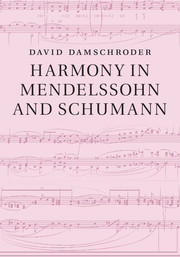Book contents
- Harmony in Mendelssohn and Schumann
- Harmony in Mendelssohn and Schumann
- Copyright page
- Contents
- Preface
- Part I Methodological orientation: harmonic analysis through listening
- Part II Masterpieces
- Notes
- Select bibliography
- Index of Mendelssohn’s works
- Index of Schumann’s works
- Index of names and concepts
- References
Select bibliography
Published online by Cambridge University Press: 09 November 2017
- Harmony in Mendelssohn and Schumann
- Harmony in Mendelssohn and Schumann
- Copyright page
- Contents
- Preface
- Part I Methodological orientation: harmonic analysis through listening
- Part II Masterpieces
- Notes
- Select bibliography
- Index of Mendelssohn’s works
- Index of Schumann’s works
- Index of names and concepts
- References
- Type
- Chapter
- Information
- Harmony in Mendelssohn and Schumann , pp. 271 - 276Publisher: Cambridge University PressPrint publication year: 2017



